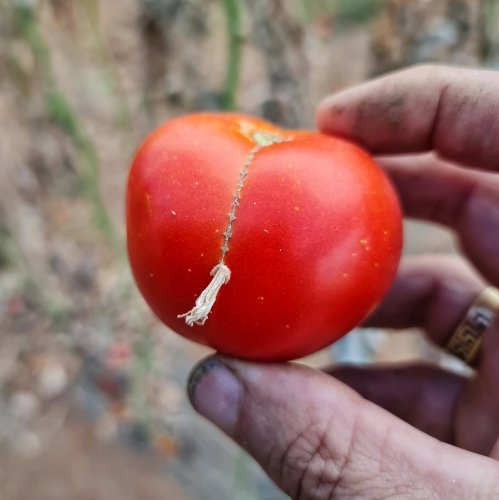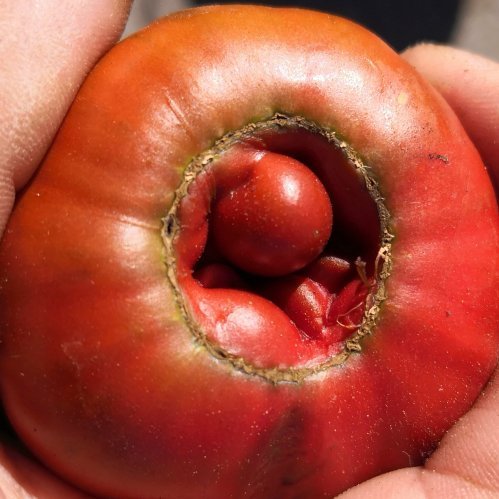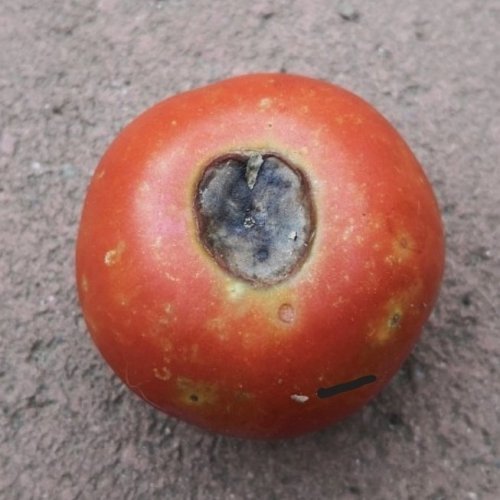Tomato problems #1: zippering, catfacing, splitting & blossom end rot
I think that I’m safe in saying that tomatoes are nearly everyone’s favourite fruits. Unfortunately, that statement doesn’t just apply to human creatures but to a whole range of bugs and microbes.
This post will be about the physical and growth problems that your tomatoes might encounter and what to do about them. There’ll be another one about fungal and viral diseases and another about pest insects.
The most common (physical) tomato problems I’ve encountered –
Zippering
You may see a zipper pattern appearing on the skin of your tomato. This is caused by one of the flower’s anthers (the part that produces pollen) becoming stuck on the newly developing fruit after fertilization has occurred.

I think this is the most fascinating problem that tomatoes can have. As the fruit grows, the anther gets dragged further and the line increases in length. As most plants grow much of their anatomy on a Fibonacci sequence, the result of a well formed zipper is a spiral.
Humidity is one suggested cause of zippering. High humidity makes the pollen end of the anther stickier than usual, increasing its chances of getting stuck.
Some sources have shown that the zippering occurs more frequently in cold weather, so a cold snap during flowering time could be the culprit.
Some tomato varieties are less prone to zippering but, beside growing your plants in a temperature and humidity controlled greenhouse, there’s not a lot that you can do about zippering – it will appear here and there on yout tomato bushes or vines. It’s a cosmetic problem that won’t affect the taste of the fruit though it is possible that the tomato will split somewhere along the zipper and allow access to the soft insides by nefarious critters.
Catfacing
The symptom of catfacing is a dimpling and puckering of the fruit that, to some, looks like a cat’s face. Severe cases can lead to scarring and splitting of the fruit. It occurs when the blossom scar becomes enlarged as the fruit grows.

There are several suggested causes for cat facing:
Temperature is one factor. A spell of cold temperatures below 16 degrees for a number of days during flowering can cause it. Extreme fluctuations between day and night temperatures has been found to increase the occurrence of catfacing.
It can be hard to keep temperatures constant unless you have a greenhouse. The other solution is to grow heirloom varieties that are less susceptible to catfacing.
Other possible causes are –
- incomplete pollination
- exposure to some pesticides
- physical damage to the blossom
- damage to the pistil from insects such as thrips
- excess nitrogen in the soil or media
Splitting

This is probably the easiest problem to resolve, though when you see it, it will be too late for the affected tomato and you’ll just have to eat it the way it is or compost it.
Splitting is caused by irregular watering or irregular rainfall. The plant takes on way too much water when it is over abundant and this forces the skin to split.
It doesn’t affect the taste of the tomato but the splits in the skin lay it open for attacks by microbes and insects.
To resolve it, remove the affected tomatoes and try to get your watering regime a little more regular both in amount and timing. In the hot weather, make sure that yout plants are well mulched. This helps the moisture levels in the soil stay more constant and will help reduce the chances of your fruit splitting.
It seems that splitting occurs more frequently in container grown tomatoes. It’s easy to let potting mix or soil in containers dry out and then we are all inclined to overwater the container to compensate.
Blossom end rot

Blossom end rot is usually caused by a nutrient deficiency. The deficient nutrient is calcium and the symptom of the deficiency are discolouration, softening and rotting of the blossom end of the tomato (the blossom end is the free end, not the one attached to the stem).
The most common cause of calcium deficiency that I’ve come across is overwatering. Lack of calcium can be caused by over- or underwatering, both of which can make it more difficult for the plant to take up this vital nutrient.
Other factors that can cause poor calcium uptake-
- incorrect pH
- high levels of salt
- physical damage to the plant’s roots
- too much nitrogen heavy fertilizer
Too much nitrogen heavy fertilizer creates a lot of leaf growth and that needs calcium too for strong cell walls. Too much leaf growth can suck the calcium away from the developing fruit and cause the problem.
To treat it, remove all of the affected fruit and dispose of them as you wish. Check your watering habits and adjust them to suit. If your tomatoes are looking lush and healthy, the best first step is to reduce the amount of water that you are giving them., then see if the issue disappears. I like this technique best because it means less work!
In the hot weather, make sure that your plants are well mulched. This helps the moisture levels in the soil stay more constant. It seems that blossom end rot occurs more frequently in container grown tomatoes. It’s easy to let potting mix or soil in containers dry out and then we are all inclined to overwater the container to compensate.
Add a calcium supplement to the plants by adding it to the soil or as a foliar spray. We have information on making your own calcium supplement at home.
One other possible factor that can cause blossom end rot is is poor fertilization.






This post has been manually curated by @steemflow from Indiaunited community. Join us on our Discord Server.
Do you know that you can earn a passive income by delegating to @indiaunited. We share 100 % of the curation rewards with the delegators.
Here are some handy links for delegations: 100HP, 250HP, 500HP, 1000HP.
Read our latest announcement post to get more information.
Please contribute to the community by upvoting this comment and posts made by @indiaunited.
Thank you! I hope the info helps our brothers and sisters in India and the surrounding area.
In the climate of the area where I live it is very difficult to grow tomatoes, we have tried a couple of times but we have not been given, the plant just does not get to bear fruit. But for me it would be wonderful to have a tomato crop in the house.
I wanted to inform you that my publication has already been edited so that the format presented in relation to the language would suit the community, so that it can be unmuted. If there are any changes I need to make to make this happen, I would like to know.
I was not told what the reason for the mute was but I took the initiative to edit the post to try to fix the problem so I could continue to share the content with the community, since it is the introduction to my garden.
Thank you.
In some places, it is difficult to grow tomatoes and in those areas a greenhouse certainly helps. Whereabouts are you? We have community members from all around the world. Maybe someone is near you who has found the secret to growing them.
I haven't been online much so haven't seen your post. There're guidelines in this group about picture only and low effort posts (just a pic and a few lines)and a guideline about using English. I'm not a fan of the last one but the folks who built the hivegarden community before I came along decided it was best. If that's the case there are many posts with dual languages that you can learn that style from.
Certainly. I am in Venezuela, right now I am on an island, the land is particularly dry, with a lot of sun and little rain, although every time storms pass through the country, this is one of the affected areas. For a couple of weeks now we have been having rain, at least that has helped my garden, fortunately none of it has suffered.
The people in the area that I know have not told me that they have been able to grow tomatoes, as far as I know, they prefer to invest the time and money growing plants that have a better chance of survival, so that they can profit. Perhaps that is one of the reasons why tomatoes have a somewhat high price in the area, because they have to come from other regions by ship mostly.
On the subject of my publication... I guess it was simply the main language I used, which was Spanish, although it had its English translation. Otherwise I have a lot of my own images and a considerable number of words. Anyway, at this point I guess it's going to stay muted, the only thing left for me to do is to publish a new post with the English language first and that's it.
Thank you very much for your answer.
So complex good to have these informations
!1UP
There's a lot more to come. Tomatoes have their issues.
You have received a 1UP from @gwajnberg!
@ctp-curator, @stem-curator, @vyb-curator, @pob-curator
And they will bring !PIZZA 🍕.
Learn more about our delegation service to earn daily rewards. Join the Cartel on Discord.
Thank you @gwajnberg!
I gifted $PIZZA slices here:
@curation-cartel(7/20) tipped @ligayagardener (x1)
Please vote for pizza.witness!
Thanks!
That explains this!
I reckon it does!
Actually, tomatoes fruits on fields are associated with much problems; whether in hot or temperate seasons. I learnt when there is excess moisture content or rainfall it causes a lot of that splitting of tomato fruits. What ever be the case we cannot get 100% purity of fruits devoid of some of these challenge, but we can control to some extent to get higher yield.
That sound a great 😃👍 post in the community. I really enjoyed reading.